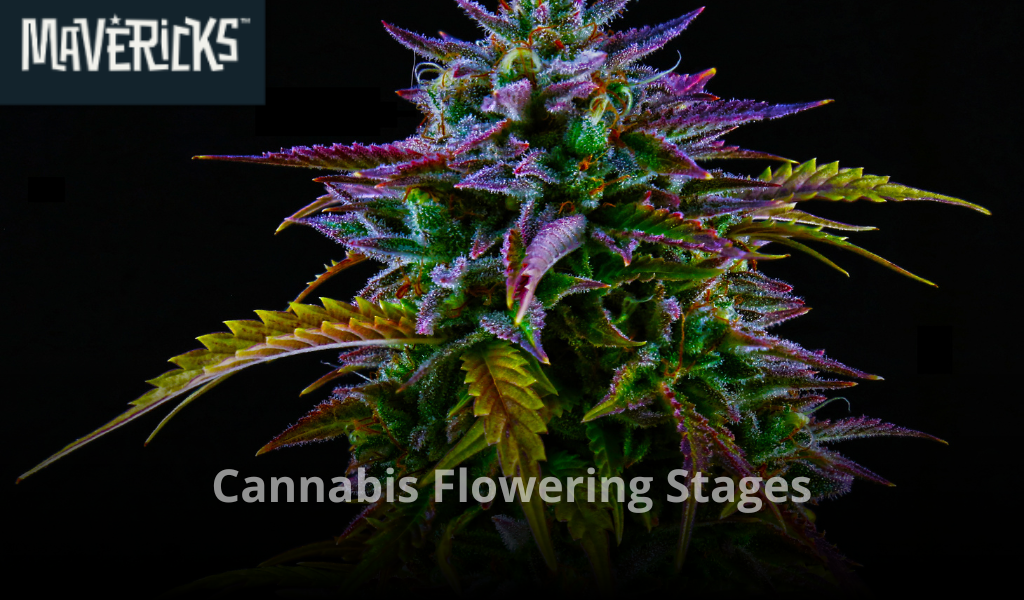The flowering stage is the most exciting and critical part of your cannabis grow. It's when your plants shift from growing leaves to producing the resin-packed buds you're waiting for. But to get the best results, you need to understand how the flowering stages unfold—and what your plants need at each step.
In this guide, we break down the cannabis flowering stages week by week, highlighting visual cues, optimal conditions, and best practices. Whether you're growing indoors or outdoors, from feminized seeds or elite genetics like those from Mavericks Genetics USA, mastering this phase will maximize your yield and potency.
How long is the cannabis flowering stage?
The flowering phase typically lasts 8 to 10 weeks, depending on the strain:
-
Indica-dominant strains: 7–9 weeks
-
Sativa-dominant strains: 9–12 weeks
-
Hybrids: 8–10 weeks
Autoflowers have shorter flowering times, often completing the process in just 5–8 weeks from bloom initiation.
Week-by-week cannabis flowering stages
Pre-flowering (Transition): Week 1–2
This stage begins when the plant receives 12 hours of uninterrupted darkness per day.
What to expect:
-
Stretching: Plants may double in size.
-
Formation of pre-flowers: White pistils (hairs) begin to appear.
-
Increased nutrient demand: Especially phosphorus and potassium.
Tips:
-
Support stretching branches early.
-
Reduce nitrogen; increase bloom nutrients.
-
Keep humidity under 50% to avoid mold.
Early Flowering: Week 3–4
The plant’s energy shifts from vertical growth to bud production.
What to expect:
-
Bud sites become more defined.
-
White pistils multiply at each node.
-
Trichome production begins.
Tips:
-
Maintain strong airflow around bud sites.
-
Monitor humidity and temperature closely.
-
Start low-stress training (LST) if needed to open the canopy.
Mid-Flowering: Week 5–6
This is when buds begin to fatten and trichome production ramps up.
What to expect:
-
Buds bulk up visibly.
-
Sticky resin starts forming.
-
Aromas intensify significantly.
-
Pistils may start turning orange or amber.
Tips:
-
Check for pest activity around developing buds.
-
Avoid touching buds—resin is delicate.
-
Adjust nutrients to reduce nitrogen and increase potassium.
Late Flowering: Week 7–8
Your plants are nearing the end of their life cycle and preparing for harvest.
What to expect:
-
Buds reach peak density.
-
Pistils mostly darken and curl inward.
-
Trichomes shift from clear → cloudy → amber.
Tips:
-
Flush your plants with pH-balanced water (optional).
-
Watch trichomes with a jeweler’s loupe for harvest timing.
-
Reduce humidity below 45% to prevent bud rot.
Ripening (Optional Weeks 9–10)
Some strains need extra time to fully mature and develop potency.
What to expect:
-
Swelling calyxes
-
Maximum trichome production
-
Most pistils have darkened
-
Aromas are at their strongest
Tips:
-
Avoid adding nutrients—focus on flushing and monitoring ripeness.
-
Start planning harvest room conditions.
-
Keep stress minimal—no pruning or major changes.
How to tell when your cannabis is ready to harvest
The best way to know your buds are ready isn’t just by the calendar—it’s by looking closely at the trichomes and pistils.
|
Indicator |
Ready for Harvest? |
|
Pistils |
70–90% darkened and curled in |
|
Trichomes |
Mostly cloudy with 10–30% amber |
|
Bud Structure |
Dense, swollen, and sticky |
Key nutrients during flowering
|
Stage |
N |
P |
K |
|
Week 1–2 |
↓ |
↑ |
↑ |
|
Week 3–6 |
– |
↑↑ |
↑↑ |
|
Week 7+ |
↓ |
– |
– |
-
Use bloom boosters for heavier buds. -
Avoid overfeeding in late flowering to preserve flavor.
-
Flush 1–2 weeks before harvest to remove residual salts (optional).
Common mistakes during flowering
|
Mistake |
Result |
How to Fix |
|
Overwatering |
Root rot, slowed growth |
Let topsoil dry between watering |
|
High humidity |
Bud mold, mildew |
Keep below 50% RH |
|
Light leaks |
Reverted to veg phase |
Ensure 12 hours of darkness |
|
Overfeeding |
Nutrient burn |
Flush and reduce ppm |
Indoor vs outdoor flowering
|
Environment |
Pros |
Cons |
|
Indoor |
Full control, multiple harvests/year |
Costly setup, space limited |
|
Outdoor |
Natural sun, large plants |
Weather risks, seasonal only |
At Mavericks Genetics USA, our feminized seeds are optimized to perform in both environments. Choose the best flowering genetics for your grow zone and style.
Flowering is where the magic happens
The flowering stage is where all your hard work pays off. By understanding each week’s needs and watching your plants closely, you’ll maximize resin production, yield, and terpene profiles.
Whether you're chasing bag appeal or seed production, the right genetics and smart flowering practices make all the difference.
Ready to start a grow that ends with elite results?
Shop Mavericks Genetics USA for top-tier feminized seeds bred for potency, flavor, and consistency—flower after flower.

Share:
Major Cannabis Terpenes and Terpene Chart: Understanding the Aromatic Soul of Cannabis
7 Most Common Cannabis Deficiencies and How to Fix Them